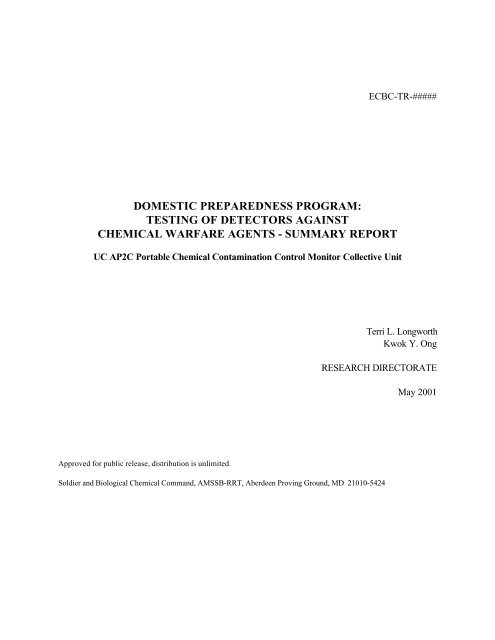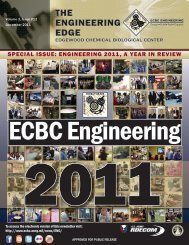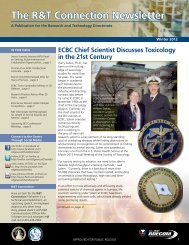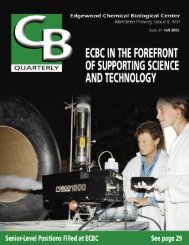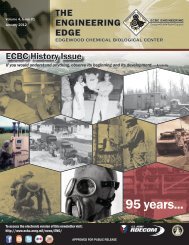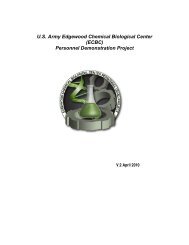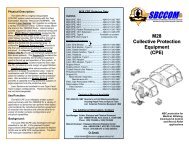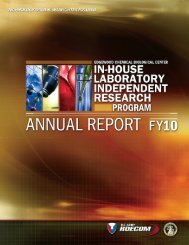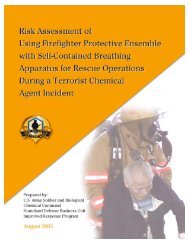testing of detectors against chemical warfare agents - summary report
testing of detectors against chemical warfare agents - summary report
testing of detectors against chemical warfare agents - summary report
Create successful ePaper yourself
Turn your PDF publications into a flip-book with our unique Google optimized e-Paper software.
ECBC-TR-#####DOMESTIC PREPAREDNESS PROGRAM:TESTING OF DETECTORS AGAINSTCHEMICAL WARFARE AGENTS - SUMMARY REPORTUC AP2C Portable Chemical Contamination Control Monitor Collective UnitTerri L. LongworthKwok Y. OngRESEARCH DIRECTORATEMay 2001Approved for public release, distribution is unlimited.Soldier and Biological Chemical Command, AMSSB-RRT, Aberdeen Proving Ground, MD 21010-5424
DisclaimerThe findings in this <strong>report</strong> are not to be construed as an <strong>of</strong>ficial Department <strong>of</strong> the Army positionunless so designated by other authorizing documents.
REPORT DOCUMENTATION PAGEForm ApprovedOMB No. 0704-0188Public <strong>report</strong>ing burden for this collection <strong>of</strong> information is estimated to average 1 hour per response, including the time for reviewinginstructions, searching existing data sources, gathering and maintaining the data needed, and completing and reviewing the collection <strong>of</strong>information. Send comments regarding this burden estimate or any other aspect <strong>of</strong> this collection <strong>of</strong> information, including suggestions forreducing this burden, to Washington Headquarters Services, Directorate for Information Operations and Reports, 1215 Jefferson Davis Highway,Suite 1204, Arlington, VA 22202-4302, and to the Office <strong>of</strong> Management and Budget, Paperwork Reduction Project (0704-0188), Washington,DC 20503.1. AGENCY USE ONLY (Leave Blank) 2. REPORT DATEMay 20013. REPORT TYPE AND DATES COVEREDFinal; 00 May – 00 Aug4. TITLE AND SUBTITLEDOMESTIC PREPAREDNESS PROGRAM: TESTING OF DETECTORSAGAINST CHEMICAL WARFARE AGENTS - SUMMARY REPORT. UC AP2CPortable Chemical Contamination Control Monitor Collective Unit5. FUNDING NUMBERSNone6. AUTHOR(S)Longworth, Terri L; Ong, Kwok Y.7. PERFORMING ORGANIZATION NAME(S) AND ADDRESS(ES)DIR, ECBC, ATTN: AMSSB-RRT, APG, MD 21010-54248. PERFORMING ORGANIZATIONREPORT NUMBERECBC–TR-9. SPONSORING/MONITORING AGENCY NAME(S) AND ADDRESS(ES)Program Director, Domestic Preparedness, 5183 Blackhawk Road,ATTN: AMSSB-RTD, APG, MD 21010-542410. SPONSORING/MONITORINGAGENCY REPORT NUMBER11. SUPPLEMENTARY NOTES12a. DISTRIBUTION/AVAILABILITY STATEMENTApproved for public release; distribution is unlimited.13. ABSTRACT (Maximum 200 words)12b. DISTRIBUTION CODEThis <strong>report</strong> characterizes the <strong>chemical</strong> <strong>warfare</strong> (CW) agent detection potential <strong>of</strong> the commercially available UC AP2C PortableChemical Contamination Control Monitor Collective Unit. These <strong>chemical</strong> agent <strong>detectors</strong> were tested <strong>against</strong> HD, GB and GAvapor at various conditions. This <strong>report</strong> is intended to provide the emergency responders concerned with CW agent detectionan overview <strong>of</strong> the detection capabilities <strong>of</strong> these <strong>detectors</strong>.14. SUBJECT TERMSHD Vapor <strong>testing</strong> Chemical Warfare Agent DetectionGB Detector <strong>testing</strong> Interference <strong>testing</strong>GA Liquid Testing Flame Spectrophotometer17. SECURITYCLASSIFICATION OFREPORT18. SECURITY CLASSIFICATIONOF THIS PAGE19. SECURITY CLASSIFICATION OFABSTRACT15. NUMBER OF PAGES1916. PRICE CODE20. LIMITATION OF ABSTRACTULUNCLASSIFIEDUNCLASSIFIEDUNCLASSIFIEDNSN 7540-01-280-5500 Standard Form 298 (Rev. 2-89)Prescribed by ANSI Std. Z39-18298-102
Blank
PREFACEThe work described herein was authorized under the Expert Assistance (Equipment Test)Program for the U.S. Army Soldier and Biological Chemical Command (SBCCOM) Program Directorfor Domestic Preparedness. This work was started in May 2000 and was completed in August 2000.The use <strong>of</strong> either trade or manufacturers’ names in this <strong>report</strong> does not constitute an <strong>of</strong>ficialendorsement <strong>of</strong> any commercial products. This <strong>report</strong> may not be cited for purposes <strong>of</strong> advertisement.This <strong>report</strong> has been approved for public release. Registered users should request additionalcopies from the Defense Technical Information Center; unregistered users should direct such requests tothe National Technical Information Service.AcknowledgmentsThe authors acknowledge John Baranoski, Juan C. Cajigas, Jacob Barnhouse and MarciaJohnson for their assistance in performing agent <strong>testing</strong>; and Frank DiPietro for his assistance in testplanning, acquisition, and review.The authors are grateful to the following members <strong>of</strong> the Expert Review Panel for EquipmentTesting, for their constructive reviews and comments:Dr. Jimmy Perkins, University <strong>of</strong> Texas School <strong>of</strong> Public Health, San Antonio, TXDr. Bruce A. Tomkins, Ph.D., Organic Chemistry Section, Chemical and Analytical SciencesDivision, Oak Ridge National Laboratory, Oak Ridge, TNDr. Edward T. Zellers, University <strong>of</strong> Michigan School <strong>of</strong> Public Health, Ann Arbor, MILeo F. Saubier, Battelle Memorial Institute, Edgewood, MD1
2Blank
TABLE OF CONTENTS1 INTRODUCTION..................................................................................................................................................................52 OBJECTIVE...........................................................................................................................................................................53 SCOPE....................................................................................................................................................................................54 EQUIPMENT AND TEST PROCEDURES ........................................................................................................................64.1 DETECTOR DESCRIPTION ...................................................................................................................................... 64.2 CALIBRATION........................................................................................................................................................... 94.3 AGENT CHALLENGE ................................................................................................................................................ 94.4 AGENT VAPOR QUANTIFICATION ................................................................................................................... 104.5 SURFACE CONTAMINATION SAMPLE CHALLENGE................................................................................... 114.6 FIELD INTERFERENCE TESTS.............................................................................................................................. 114.7 LABORATORY INTERFERENCE TESTS............................................................................................................. 125 RESULTS AND DISCUSSION.........................................................................................................................................125.1 MINIMUM DETECTABLE LEVELS ...................................................................................................................... 125.2 TEMPERATURE AND HUMIDITY EFFECTS..................................................................................................... 135.3 SURFACE CONTAMINATION TEST .................................................................................................................. 155.4 FIELD INTERFERENCE ........................................................................................................................................... 165.5 LABORATORY INTERFERENCE TESTS............................................................................................................. 176 CONCLUSIONS .................................................................................................................................................................18FIGURES1. AP2C Monitor............................................................................................................................ 72. S4PE Surface Sampler and Associated Sampling Tips and Nozzles.............................................. 9TABLES1. Minimum Detectable Level (MDL) with 2 Bar Response From AP2C at Ambient Temperaturesand 50% Relative Humidity....................................................................................................... 132. AP2C Responses to HD Vapor Concentrations at Various Conditions....................................... 143. AP2C Responses to GA Vapor Concentrations at Various Conditions....................................... 144. AP2C Responses to GB Vapor Concentrations at Various Conditions ....................................... 155. Liquid Surface Contamination Response Results ........................................................................ 166. AP2C Field Interference Testing Summary................................................................................ 177. Results <strong>of</strong> Laboratory Interference Tests With CW Agents......................................................... 188. Results <strong>of</strong> Laboratory Interference Tests Without CW Agents.................................................... 183
Blank4
DOMESTIC PREPAREDNESS PROGRAM:TESTING OF DETECTORS AGAINSTCHEMICAL WARFARE AGENTS - SUMMARY REPORTUC AP2C Portable Chemical Contamination Control Monitor CollectiveUnit1 INTRODUCTIONThe Department <strong>of</strong> Defense (DOD) formed the Domestic Preparedness (DP) Program in 1996in response to Public Law 104-201. One <strong>of</strong> the objectives is to enhance federal, state and localcapabilities to respond to Nuclear, Biological and Chemical (NBC) terrorism incidents. Emergencyresponders who encounter a contaminated or potentially contaminated area must survey the area for thepresence <strong>of</strong> toxic or explosive vapors. Presently, the vapor <strong>detectors</strong> commonly used are not designedto detect and identify <strong>chemical</strong> <strong>warfare</strong> (CW) <strong>agents</strong>. Little data are available concerning the capability<strong>of</strong> the commonly used, commercially available detection devices to detect CW <strong>agents</strong>. Under theDomestic Preparedness (DP) Expert Assistance (Test Equipment) Program, the U.S. Army Soldier andBiological Chemical Command (SBCCOM) established a program to address this need. The AppliedChemistry Team (ACT), formerly known as the Design Evaluation Laboratory (DEL), at AberdeenProving Ground, Edgewood, Maryland, performed the detector <strong>testing</strong>. ACT is tasked with providingthe necessary information to aid authorities in the selection <strong>of</strong> detection equipment applicable to theirneeds.Several instruments were evaluated and <strong>report</strong>ed during Phase 1 <strong>testing</strong> in 1998 and Phase 2<strong>testing</strong> in 1999. Phase 3 continues the evaluation <strong>of</strong> available <strong>detectors</strong>, including the UC AP2CPortable Chemical Contamination Control Monitor Collective Unit from Proengin, France <strong>report</strong>edherein. In addition, Phase 3 evaluations include the SABRE-2000 from Barringer Corp., the ppbRAEPhoto-Ionization Detector from RAE Systems, the SAW MiniCAD from MicroSensor Systems, Inc.,and the CAM (Type L) from Graseby Dynamics Ltd., which will be <strong>report</strong>ed separately.2 OBJECTIVEThe objective <strong>of</strong> this test is to assess the capability and general characteristics <strong>of</strong> the UC AP2CPortable Chemical Contamination Control Monitor Collective Unit to detect <strong>chemical</strong> <strong>warfare</strong> agentvapors. The intent is to provide the emergency responders concerned with CW agent detection anoverview <strong>of</strong> the detection capabilities <strong>of</strong> the instruments.3 SCOPEThis evaluation attempts to characterize the CW agent detection capability <strong>of</strong> the UC AP2C.Due to time and resource limitations, the investigation is only concerned with Tabun (GA), Sarin (GB),and Mustard (HD). These representative CW <strong>agents</strong> are believed to be the most likely threats. Test5
procedures follow the established Domestic Preparedness Detector Test and Evaluation Protocol basedon the Phase 1 Test Report 1 . The test concept was as follows:a. Determine the minimum concentration levels (Minimum Detectable Level, MDL) whererepeatable detection readings are achieved for each CW agent tested. The militaryJoint Services Operational Requirements (JSOR) 2 for point sampling <strong>detectors</strong> servedas a guide for detection sensitivity objectives.b. Investigate the humidity and temperature effects on detector response.c. Observe the effects <strong>of</strong> potential interfering vapors upon detector performance both inthe laboratory and in the field.4 EQUIPMENT AND TEST PROCEDURES4.1 DETECTOR DESCRIPTIONProengin Inc., 78210 Saint Cyr L’Ecole, France, is the manufacturer <strong>of</strong> the UC AP2C PortableChemical Contamination Control Monitor Collective Unit. The manufacturer explains that the collectiveunit (UC) includes the vapor monitor (AP2C) and the liquid or solid substance sampler (S4PE). TheAP2C is a flame spectrophotometer that uses a hydrogen burner to heat a sample allowing the elementsto produce their characteristic spectral emissions for detection. The S4PE surface sampler is theevaporation system that allows sampling <strong>of</strong> liquids and solids by the detector. The DomesticPreparedness program procured three UC AP2C units. Two were included in the detector evaluationsand randomly labeled A and B. The third unit was reserved for a backup where necessary. Figure 1 isa photograph <strong>of</strong> the AP2C monitor.6
Figure 1. AP2C MonitorThe AP2C is a lightweight, hand-held point detector that is capable <strong>of</strong> detecting nerve andblister <strong>agents</strong> simultaneously. The manufacturer’s Operating Instructions Manual 3 states the temperatureperformance range from -32°C to +55°C. The instrument weighs 2.09 kg including the 7.3V lithiumbattery pack and hydrogen storage device. The battery pack, which slides into a battery drawer,contains two LSH20, liquid cathode, lithium thionyl chloride batteries. According to the manufacturer, abattery pack will last for 24 hours at 20°C and 11 hours at 0°C.The detector is easy to use with a simple on/<strong>of</strong>f turn <strong>of</strong> the inserted hydrogen cylinder. Thedisplay lights will all flash on upon insertion <strong>of</strong> the cylinder. Then a blinking yellow ‘WAIT’ lightindicates initialization <strong>of</strong> the instrument. During initialization, the unit is automatically pre-heated, thehydrogen circuit is purged, and the flame is ignited. The green ‘READY’ lights up when the unit is readyfor use. This start up time is given in the operator’s manual as less than 2 minutes at temperatures above0°C and up to 15 minutes at temperatures below 0°C. A yellow ‘H2’ light warns the operator whenthe hydrogen cylinder is about to be depleted. The hydrogen cylinder provides approximately 12 hours<strong>of</strong> operation when fully charged. The heat from the flame decontaminates the internal surfaces, whichallows fast recovery times.A photocell measures the luminous variations <strong>of</strong> the flame emissions to provide the detectionsignal <strong>of</strong> substances in the air. A micro-processing controller board processes the electrical signal fromthe photocell to assess the hazard. GA and GB are detected by analyzing the phosphorous emissionspectrum. HD detection relies on the emission spectrum <strong>of</strong> sulfur. Alternating internal light filters forphosphorus and sulfur spectra detection allow both nerve and blister agent detection without the need <strong>of</strong>manually changing the detection mode.7
There are two columns <strong>of</strong> five detection bars on the instrument display that indicate thedetector’s response by lighting one to five alarm bars. The first bar is yellow and the next four are red.Increasing number <strong>of</strong> red bars represent higher detected concentration. The left column represents“phosphorus (nerve)” detection and the right column represents “sulfur (HD)” detection. All fivedetection bars will be blinking when concentration exceeds the fifth level maximum detection setting.The operator’s manual states that the hazard threshold for unprotected humans is reached as soon asthe first red indicator lights. A buzzer is supplied with the detector that can be clipped onto the AP2Chandle to provide an audible alarm signal corresponding to the visual response.During normal vapor operation, sample air is drawn into the AP2C unit through the changeable“vapor-sampling” nozzle at a sampling rate <strong>of</strong> 80 liters per hour (1.33 liters per minute). The analysisairflow in the burner <strong>of</strong> the AP2C is 3.5 liters/hour (58 milliliters/minute).The S4PE persistent substances sampling and evaporation system requires the AP2C nozzle tobe changed before use. The “sampling pipe” nozzle, one <strong>of</strong> three types <strong>of</strong> nozzles supplied, is fitted tothe AP2C in place <strong>of</strong> the “vapor-sampling” nozzle to enable liquid detection using the S4PE scrapers.The sampling pipe nozzle needed for S4PE use has a shorter stem than the vapor-sampling nozzle. Theshorter stem length places the detector into a less sensitive detection mode for liquid detection, which isindicated by the flashing green “ready” light. The S4PE uses a 3.5V lithium battery and a replaceablescraper tip that is made from a small piece <strong>of</strong> flexible heat tape. The sample is manually collected usingthe scraper tip, then heat desorbed from the scraper by pressing a button. This vaporizes the collectedsample to enable analysis by the AP2C.The third nozzle is marked with a “red cross” and allows the S4PE surface sampler to be usedwhile retaining the high sensitivity capability <strong>of</strong> the instrument similar to that <strong>of</strong> using the vapor-samplingnozzle. The “red cross sampling pipe” is intended for low-level detection for medical surveillance tomonitor potentially contaminated or decontaminated surfaces (i.e., skin or clothing). Figure 2 shows theS4PE and the associated sampling tips and nozzles.8
Figure 2. S4PE Surface Sampler and AssociatedSampling Tips and Nozzles4.2 CALIBRATIONOperating procedures were followed according to the operator’s manual. The instrumentsensitivity is pre-set at the factory. The manufacturer provides confidence sampler tips to performfunctional checks to assure detection performance. The confidence sampler tip is used with the S4PE inplace <strong>of</strong> the liquid sampler scraper tip. During the confidence check, response signals will occur withinseconds for both alarm bar columns upon heating the simulant sample tip using the S4PE procedures.The confidence sampler tips contain <strong>chemical</strong>s that cause an AP2C response signal for both phosphorusand sulfur.4.3 AGENT CHALLENGEThe agent challenges were conducted using the Multi-Purpose Chemical Agent VaporGeneration System 4 with greater than 80% purity CW agent GA and available Chemical AgentStandard Analytical Reference Material (CASARM) grade CW <strong>agents</strong> GB and HD. Agent <strong>testing</strong>followed successful instrument start up and confidence check. The vapor generator system permits<strong>testing</strong> <strong>of</strong> the instrument with humidity and temperature-conditioned air without agent vapor to assure thebackground air does not interfere before challenging it with similarly conditioned air containing the CWagent vapor. With the instrument’s inlet placed under the cup-like sampling port <strong>of</strong> the vapor generator,9
the AP2C unit is exposed to the conditioned air for approximately one minute to establish a stablebackground and ensure that the instrument does not exhibit undesired responses to the air.Agent challenge began when the solenoids <strong>of</strong> the vapor generation system were energized toswitch the air streams from conditioned air only to similarly conditioned air containing the agent. Eachdetector was tested three times under each condition. The <strong>detectors</strong> were exposed to the agent vaporto determine the concentration and time for response for each <strong>of</strong> the bar levels. As each bar level wasattained, the exposure time was intentionally extended two minutes, concentration kept constant, todetermine if the bar level would not change. The time required after agent exposures until the instrumentstopped responding was recorded as the recovery time.The <strong>detectors</strong> were each tested with the <strong>agents</strong> GA, GB and HD at different concentrationlevels at ambient temperatures (22 o C to 28 o C) at 50% relative humidity to determine the minimumdetectable level (MDL). In addition, the <strong>detectors</strong> were tested at relative humidity conditions <strong>of</strong> 90%, and at temperature extremes <strong>of</strong> -30°C for GA and GB, 0°C for HD, and +55°C for thethree CW <strong>agents</strong> to observe temperature and humidity effects. Temperature extremes were based onthe manufacturer’s stated operating range using agent concentrations that approximated the MDL. HDcould not be tested below 0°C due to physical property limitations. Although HD freezes atapproximately +15°C, the calculated HD volatility <strong>of</strong> 92 mg/m 3 at 0°C easily produces a vaporconcentration higher than the 2 mg/m 3 JSOR detection criteria allowing the instrument to be evaluated at0°C.4.4 AGENT VAPOR QUANTIFICATIONThe generated agent vapor concentrations were analyzed independently and <strong>report</strong>ed in mg/m 3 ,as well as in parts-per-million (ppm) units in the results tables. The vapor concentration was quantifiedby utilizing the manual sample collection methodology 5 using the Miniature Continuous Air MonitoringSystem (MINICAMS ® ) manufactured by O. I. Analytical, Inc., Birmingham, Alabama. TheMINICAMS ® is equipped with a flame photometric detector (FPD), and it was operated inphosphorus mode for the G <strong>agents</strong> and sulfur mode for HD.This system normally monitors air by collection through sample lines and subsequently adsorbingthe CW agent onto the solid sorbent contained in a glass tube referred to as the pre-concentrator tube(PCT). The PCT is located after the MINICAMS ® inlet. Then the concentrated sample is periodicallyheat desorbed into a gas chromatographic capillary column for subsequent separation, identification, andquantification. For manual sample collection, the PCT was removed from the MINICAMS ® during itssampling cycle and connected to a measured suction source to draw the vapor sample from the agentgenerator. The PCT was then re-inserted into the MINICAMS ® for analysis. This “manual samplecollection” methodology eliminates potential loss <strong>of</strong> sample along the sampling lines and the inletassembly when the MINICAMS ® is used as an analytical instrument. The calibration <strong>of</strong> theMINICAMS ® was performed daily using the appropriate standards for the agent <strong>of</strong> interest. Themeasured mass equivalent (derived from the MINICAMS chromatogram) divided by the total volume10
(flow rate multiplied by time) <strong>of</strong> the vapor sample drawn through the PCT produces the sampleconcentration that converts into mg/m 3 .4.5 SURFACE CONTAMINATION SAMPLE CHALLENGEThe UC AP2C has the capability to monitor surface contamination with the use <strong>of</strong> the S4PESurface Sampler Probe. A limited side evaluation <strong>of</strong> this feature was conducted using GB and HD atroom temperature. Liquid agent droplets on four types <strong>of</strong> surfaces including asphalt, concrete, fabricfrom the battle dress uniform (BDU), and wood were tested. Five drops (each drop contains 0.2microliters) <strong>of</strong> neat agent were transferred onto approximately one cm 2 area <strong>of</strong> the respective surface tosimulate a surface contamination concentration <strong>of</strong> 10 g/m 2 . Fifteen or more minutes were allowed forthe agent to soak into the surface. The surface was then swiped with the S4PE equipped with thesampling tip and analyzed with the AP2C fitted with the shorter sampling pipe nozzle. The S4PE tipwas examined and again heat desorbed to assure no presence <strong>of</strong> residual agent after each challenge. Ifthe tip was damaged, or still had residual agent present, it was replaced. Otherwise, the tip was reusedfor subsequent tests. The contaminated surface was swiped again with the S4PE and analyzed by theAP2C unit using the longer medical (marked with red cross) nozzle after approximately one hour for GBand two hours for HD, to observe if the residual agent remained detectable. This evaluation wasperformed using one S4PE per AP2C.4.6 FIELD INTERFERENCE TESTSThe instruments were tested outdoors in the presence <strong>of</strong> common potential interferents such asthe vapors from gasoline, diesel fuel, jet propulsion fuel (JP8), kerosene, Aqueous Film Forming Foam(AFFF, used for fire fighting), household chlorine bleach and insect repellent. Vapor from a 10% HTHslurry (a chlorinating decontaminant for CW <strong>agents</strong>), engine exhausts, burning fuels and other burningmaterials were also tested. The objective was to assess the ability <strong>of</strong> the instruments to withstandoutdoor environments and to resist responding when exposed to the selected substances.The field tests were conducted outdoors at M-Field <strong>of</strong> the Edgewood Area <strong>of</strong> AberdeenProving Ground in August 2000. These experiments involved open containers, truck engines and firesproducing smoke plumes, which were sampled by the <strong>detectors</strong> at various distances downwind. TheAP2Cs were carried to the smoke or fume test plume to achieve moderate but not exaggeratedexposures (e.g. 0.5-2 meters for vapor fumes and 2-5 meters for smokes).Confidence checks were performed on each detector at the beginning <strong>of</strong> each <strong>testing</strong> day andperiodically between tests. The two units were exposed to each interferent for three trials, in general.Testing continued with the next challenge after the instruments were thoroughly recovered from priorexposure.11
4.7 LABORATORY INTERFERENCE TESTSThe laboratory interference tests were designed to assess the effect on the <strong>detectors</strong> <strong>of</strong> vaporexposure from potential interfering substances. The substances were chosen based on the likelihood <strong>of</strong>their presence during an emergency response by first responders. Additionally, the laboratoryinterference tests were conducted to assess the ability <strong>of</strong> the <strong>detectors</strong> to detect CW agent in thepresence <strong>of</strong> the selected vapor (diesel fuel or Aqueous Film Forming Foam (AFFF) liquid). For ease<strong>of</strong> generating 0.1% and 1% vapor concentrations in the laboratory hood, liquid AFFF was used.The units were tested <strong>against</strong> 1% <strong>of</strong> the headspace concentrations <strong>of</strong> vapors <strong>of</strong> gasoline, JP8,diesel fuel, household chlorine bleach, floor wax, AFFF, Spray 9 cleaner, Windex, toluene and vinegar.They were also tested <strong>against</strong> 25 ppm NH 3 (ammonia). If the detector false alarmed at 1%concentration, it was tested at the 0.1% concentration <strong>of</strong> the substance. A dry air stream carries theheadspace vapor <strong>of</strong> the substance by sweeping it over the liquid in a tube or through the liquid in abubbler to prepare the interferent gas mixture. Thirty milliliters/minute or three milliliters/minute <strong>of</strong> thisvapor saturated air was then diluted to three liters/minute with the conditioned air at 23°C and 50% RHto produce the 1% or 0.1% concentration <strong>of</strong> interferent test mixture, respectively. The 25 ppmammonia was derived by proper dilution <strong>of</strong> a stream from an analyzed 1% NH 3 vapor (10,000ppm)compressed gas cylinder diluted with the appropriate amount <strong>of</strong> the conditioned air.For the tests that included CW agent, the interferent test gas mixture was prepared similarly.The resultant stream <strong>of</strong> three liters/min <strong>of</strong> CW agent concentration was used as the dilution stream toblend in with the 3 or 30 milliliter per minute <strong>of</strong> the substance vapor to obtain the desired 0.1 or 1%mixture <strong>of</strong> the substance vapor in the presence <strong>of</strong> CW agent concentration. The two units were testedthree times with each agent/interferent combination.5 RESULTS AND DISCUSSION5.1 MINIMUM DETECTABLE LEVELSThe minimum detectable level (MDL) for the two AP2C units tested are shown in Table 1 foreach agent at ambient temperatures and 50% RH. The MDL values represent the lowest CW agentconcentration that consistently produced a two bar response. The units detected G <strong>agents</strong> atapproximately 0.02-0.03 mg/m 3 and HD at 0.9 mg/m 3 with two bar responses. The current militaryrequirements for CW agent detection (Joint Service Operational Requirements [JSOR] for CW <strong>agents</strong>ensitivity for point detection alarms), the Army’s current established values for Immediate Danger toLife or Health (IDLH), and the Airborne Exposure Limit (AEL) are also listed in Table 1 as referencesto compare the detector’s performance. Army Regulation (AR) 385-61 provides IDLH and AELvalues for GA/GB, and an AEL value for HD. Army regulation AR 385-61 does not establish an IDLHfor HD due to concerns over carcinogenicity.12
The AP2C units detected GA and GB at an order <strong>of</strong> magnitude below the JSOR and IDLHlevels. HD was detected at slightly below the JSOR level. Lower MDL values represent betterdetection sensitivity. The AP2C’s were unable to detect the AEL levels for GA, GB or HD.Table 1. Minimum Detectable Level (MDL) with 2 Bar Response From AP2C at AmbientTemperatures and 50% Relative HumidityAGENTConcentration in milligrams per cubic meter, mg/m 3,With parts per million values in parenthesis (ppm)and Response TimesAP2CJSOR* IDLH** AEL***MDLHD0.93 (0.142) in4-11 seconds2.0 (0.300) in120 secondsN/A0.003 (0.0005)up to 8 hoursGA0.03 (0.004) in9-36 seconds0.1 (0.015) in30 seconds0.2 (0.03)up to30 minutes0.0001 (0.000015)up to 8 hoursGB0.02 (0.003) in6-73 seconds0.1 (0.017) in30 seconds0.2 (0.03)up to30 minutes0.0001 (0.000017)up to 8 hours* Joint Service Operational Requirements for <strong>detectors</strong>.** Immediate Danger to Life or Health values from AR 385-61 to determine level <strong>of</strong> CWprotection. Personnel must wear full ensemble with SCBA for operations or full face piecerespirator for escape.*** Airborne Exposure Limit values from AR 385-61 to determine masking requirements.Personnel can operate for up to 8 hours unmasked.5.2 TEMPERATURE AND HUMIDITY EFFECTSTables 2, 3 and 4 list the range <strong>of</strong> response <strong>of</strong> the two AP2C <strong>detectors</strong> at various testconditions for HD, GA and GB, respectively. The results show the number <strong>of</strong> bars observed and thecorresponding response time at the different concentrations. Response was usually quick, with anincrease in the number <strong>of</strong> bars as the agent concentration was increased. Exposure times wereextended to two minutes to assure that the response was the maximum bar response achievable for thatconcentration level. The MDL concentration exposure responses were used to determine thetemperature and humidity effects.13
Table 2. AP2C Responses to HD Vapor Concentrations at Various ConditionsAverage ConditionsHD ChallengeConcentrationBar Response TimeTemp., C %RH mg/m 3 ppm Response (seconds)22 60 seconds at these conditions.Table 3. AP2C Responses to GA Vapor Concentrations at Various ConditionsAverage ConditionsGA ChallengeConcentrationBar Response TimeTemp., C %RH mg/m 3 ppm Response (seconds)25
Table 4. AP2C Responses to GB Vapor Concentrations at Various ConditionsGB ChallengeAverage ConditionsConcentrationTemp., C %RH mg/m 3 ppmBarResponseResponse Time(seconds)0.02 0.003 1 4-1122 12055 18 0.02 0.004 1-2 3-99*Units A and B only tested one time each due to inlet freeze up. Unit B flashed 1 bar on and <strong>of</strong>f duringexposure.Table 2 shows that the AP2C <strong>detectors</strong> demonstrated HD detection under all temperature andhumidity conditions tested. Recovery times for HD exposure at all conditions and concentrations wereless than 15 seconds. It appears that temperature and humidity had no adverse effect on HD detection.Tables 3 and 4 show that instrument responses occurred within 2 minutes for GA and GB testsat all conditions tested except at the extreme cold temperature (-30°C). Problems occurred at -30°Cwhen water vapor from hydrogen combustion would condense and freeze around the detector outlet,which interfered with the detection process. In addition, the units required longer start up times in thecold temperature. Humidity and high temperature seems to have no adverse effect on the instruments’nerve agent detection capability. Recovery times for GA and GB exposure varied with alarm response.A response up to 3 alarm bars required less than one minute to clear. However, if the response was 4or 5 alarm bars, the required recovery time increased to greater than 4 minutes and as long as 11minutes.5.3 SURFACE CONTAMINATION TESTTable 5 shows the results <strong>of</strong> the liquid surface contamination tests using the S4PE. Resultsindicate that the surface monitoring probe and nozzles were able to produce strong detection signalswhen the S4PE probe could reach the contamination. On rough surfaces such as asphalt, the ability for15
the S4PE probe to reach the contamination is hindered once the agent has completely soaked in and thesurface has dried.The HD exposures, sampled with the “medical nozzle”, which were tested approximately twohours after the deposition <strong>of</strong> the agent, were not detected except in one incident. Perhaps most <strong>of</strong> thedeposited agent was volatilized or soaked into the material such that the S4PE probe could not gathersufficient sample for detection.SurfaceAsphaltConcreteBDUWoodTable 5. Liquid Surface Contamination Response ResultsLiquid NozzleMedical NozzleGB Bar HD Bar GB Bar HD BarUnit Response Response Response ResponseA 3 NR 2 NRB NR NR 2 NRA 3 5 2 NRB 3 5 1 NRA 5 5 5 5B 5 5 4 NRA 3 5 3 NRB 3 5 2 NRNR means No ResponseLiquid Nozzle – Agent allowed to soak into surfaces for 15 minutesMedical nozzle – Agent allowed to soak into surfaces 1 hour for GB and 2 hours for HD5.4 FIELD INTERFERENCEThe results <strong>of</strong> interferent exposures are presented in Table 6. Any response means the <strong>detectors</strong>howed agent detection response in the absence <strong>of</strong> CW agent when challenged with potential interferentsubstances. The ambient temperature and relative humidity levels during these tests were in the range <strong>of</strong>27-32°C and 45-80% RH, with gentle wind. Confidence checks were successfully performed on bothunits throughout the field test evaluations.The AP2C units alarmed for tests involving burning interferents and for the engine exhausts.Only one trial with each unit was accomplished for the doused fire smoke, and neither unit alarmedduring that exposure. The alarm rates are calculated as 12 <strong>of</strong> 20 (60%) <strong>of</strong> the substances tested and 62<strong>of</strong> the 116 trials (53%). Half <strong>of</strong> the detector responses showed HD and G detection, the other halfshowed HD only responses. Post field test responses <strong>against</strong> HD and GA challenges showed theAP2C units to have no adverse residual effects from the field tests. Response characteristics weresimilar to the pre-field test results.16
Table 6. AP2C Field Interference Testing SummaryInterferent ExposuresAP2C Units A and BTotal AlarmsInterferent Total Trials # <strong>of</strong> Bars ResponseGasoline Exhaust, Idle 6 3* HGasoline Exhaust, Revved 6 5 HDiesel Exhaust, Revved 6 6 HGasoline Vapor 6 4 HDiesel Vapor 6 0JP8 Vapor 6 0Kerosene Vapor 6 0AFFF Vapor 6 0Bleach Vapor 6 0Insect Repellent 6 0HTH Vapor 6 0Burning Gasoline Smoke 6 5 H and GBurning JP8 Smoke 6 4 H and GBurning Kerosene smoke 6 6 H and GBurning Diesel Smoke 6 5 H and GBurning Cardboard Smoke 6 6 HBurning Cloth Smoke 6 6 H and GBurning Wood Fire Smoke 6 6 HDoused Wood Fire Smoke 2 0Burning Tire Smoke 6 6 HTOTAL EXPOSURES and ALARMS 116 62*Intermittent 2 bar flash5.5 LABORATORY INTERFERENCE TESTSTable 7 presents the results <strong>of</strong> <strong>testing</strong> the <strong>detectors</strong> with conditioned air containing GB or HD inthe presence <strong>of</strong> diesel fuel vapor or AFFF vapor. The tests were conducted at ambient temperatures(22°C) and 50% RH. The laboratory interference <strong>testing</strong> for agent detection capability indicates thatboth AP2C units were able to detect HD and GB in the presence <strong>of</strong> 1% diesel vapor or AFFF vaporwith similar response levels and times as without the interferents.17
Table7. Results <strong>of</strong> Laboratory Interference Tests with CW AgentsConcentrationAP2C ResponseAgent Interferent mg/m 3 ppm Bars SecondsGB 1% AFFF 0.03 0.005 2 5-10GB 1% Diesel 0.03 0.005 2 5-11HD 1% AFFF 1.5 0.23 2 3-4HD 1% Diesel 1.5 0.23 2 3-4Laboratory evaluations to determine if other potential interferent compounds would cause thedetector to false alarm are summarized in Table 8. These tests did not include use <strong>of</strong> CW agent andwere conducted at ambient temperature and 50% RH. The AP2C units did not false alarm to any <strong>of</strong>the substances at 1% <strong>of</strong> saturation except for gasoline. When gasoline vapor concentration wasreduced to the 0.1% saturation level, the AP2C showed no bar response. Those substances that didnot cause bar responses at the 1% level were not tested at the 0.1% level.6 CONCLUSIONSTable 8. Results <strong>of</strong> Laboratory Interference Tests without CW AgentsSubstanceAP2C Response1% 0.1%AFFF No Alarm Not TestedBleach No Alarm Not TestedDiesel No Alarm Not TestedFloor Wax No Alarm Not TestedGasoline 2 Bars H No AlarmJP8 No Alarm Not TestedSpray 9 No Alarm Not TestedToluene No Alarm Not TestedVinegar No Alarm Not TestedWindex No Alarm Not TestedAmmonia (25ppm) No Alarm Not TestedConclusions are based solely on the results observed during this <strong>testing</strong>. Aspects <strong>of</strong> the<strong>detectors</strong>, other than those described, were not investigated.Civilian first responders and HAZMAT personnel use Immediate Danger to Life or Health(IDLH) values to select levels <strong>of</strong> protection during management <strong>of</strong> an incident. The threshold sensitivity<strong>of</strong> the AP2C monitor was found to exceed the IDLH sensitivity requirements and the current JSORvalues for HD, GA and GB at all conditions tested. The AP2C units have also demonstrated rapid anddependable detection and recovery from HD, GA and GB exposures.18
The instruments are sensitive and can detect CW <strong>agents</strong> quickly at all humidity and temperatureextremes tested. The UC AP2C also has the capability to detect liquid surface contamination using theS4PE. Although it had difficulties detecting the residual contamination from porous surfaces such asasphalt under the tested conditions, the sampler represents an efficient means to collect, and deliver thesample to the instrument for analysis.The controlled laboratory environment tests with potential interferent substance vapors showedthe AP2C falsely responded to 1% saturation <strong>of</strong> gasoline vapor. Other tested substances, as well asgasoline vapor at the lowered concentration (0.1%), did not adversely affect the AP2C.The field interferent <strong>testing</strong>, however, showed many responses to engine exhausts and themoderately smoky environments, indicating that the instrument could be expected to give false CWdetection responses during smoky emergency situations when there may not be actual CW agent vaporpresent.19
LITERATURE CITED1. Longworth, Terri L., et al, Testing <strong>of</strong> Commercially Available Detectors Against Chemical WarfareAgents: Summary Report , ECBC-TR-033, U.S. Army Chemical Research and Engineering Center,Aberdeen Proving Ground, MD, May 1999, UNCLASSIFIED Report.2. ATCD-N, MEMORANDUM, Subject: Joint Service Operational Requirement (JSOR) for theAutomatic Chemical Agent Detector Alarm (ACADA), HQDA United States Army Training andDoctrine Command, Fort Monroe, Virginia, 3 August 1990.3. UC AP2C M266 E00 003 Operating Instructions, Proengin, 78210 Saint Cyr L’Ecole, France.4. Ong, Kwok Y., Multi-Purpose Chemical Agent Vapor Generation System, ERDEC-TR-424, U.S.Army Chemical Research and Engineering Center, Aberdeen Proving Ground, MD, July 1997,UNCLASSIFIED Report.5. Ong, Kwok Y., et al, Analytical Methodology for Quantitative Determination <strong>of</strong> O-ethyl-S-(2-Diisopropylaminoethyl) Methylphosphonothiolate (VX), ERDEC-TR-476, U.S. Army ChemicalResearch and Engineering Center, Aberdeen Proving Ground, MD, March 1998, UNCLASSIFIEDReport.20


